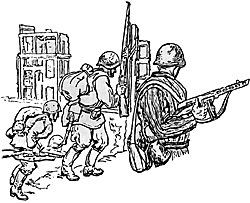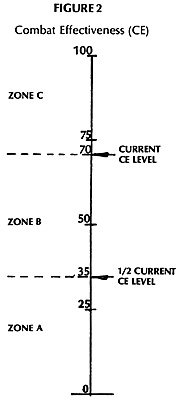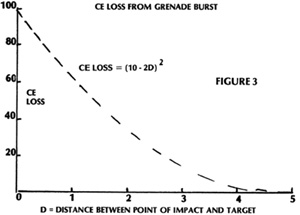INTRODUCTION
 The Potomac Wargamers (PW) is a Washington, DC
based group. Half the club members are confirmed
skirmish gamers, half are advocates of the grand tactical
battle, and the third half will play anything at any time.
We will not discuss the fourth half ...
The Potomac Wargamers (PW) is a Washington, DC
based group. Half the club members are confirmed
skirmish gamers, half are advocates of the grand tactical
battle, and the third half will play anything at any time.
We will not discuss the fourth half ...
Two PW gamers drew up the rules for a brief, modern skirmish campaign in which they utilized 54mm figures. For dioramic clarity, each figure in the skirmish had 3 separate poses: standing, kneeling, and prone. Thus if a man ran across an open field, the standing pose would be used; if he was hit and fell down, the prone pose would be placed on the table. Use of the different poses added to the visual impact of the simulation and made it quite easy for the observer to assess the situation at any given time.
The campaign pits 2 small platoons, each of 19 men, against one another. One platoon represents the People's Democratic Republic of Vorrenia; the other fights for the Worker's Free Society of Waltland. WaItland forces were headed by Wally Simon; those of Verrenia were commanded by Von Vorren. The platoons were divided into six-man squads and in any combat, only one squad per side was permitted to participate, resulting in a brief six-on-six skirmish.
This article, in more basic form, first appeared in the pages of the PW REVIEW, a monthly output of the Potomac Wargamers organization.
THE RULES
A. Firing
Weapon effect falls off linearly with range.Rifle fire, for example, has a range factor of: 99 - Range in inches, so that the Probability-of-Hit (POH) of the rifle, which has a ten round magazine, is:
- POH = (99 - Range) + (Rounds fired) + (Modifiers)
where the modifiers include such values as:
- a. Target firing from concealed position ... -30
b. Target in the open, prone . . . -20, etc.
A submachine gun has a basic range factor of: 59 Range in inches, and a revolver: 39 - Range in inches.
Percentage dice are used; a dice throw less than or equal to the POH scores a hit on the target.
The scale, using 54mm figures, is essentially one inch on the table to one yard. Thus the range factor of the rifle restricts that weapon's range to appoximately 100 yards. The rationale for this is based on the rapid tempo of the skirmish battlefield; considering the time frame involved and the fact that most firing was done hurriedly without aiming, it was decided to restrict snap shooting to the length of a football field.
Movement
Movement was governed by the use of Action Factors (AF). Each side, on each turn, receives a number of AF equal to the number of men on that side. Each man on a side can perform 2 actions per turn, with each action using up 1 AF. Thus if a 10 man squad receives 10 AF's, and 5 of them perform 2 actions each, their 10 AF allotment is gone ... the remaining 5 men must stay immobile for that turn.
The gamer, therefore, must balance his desire in keeping the entire squad moving against the need for one or two men to react to critical situations. An action is defined as: moving 3 inches, firing a weapon, loading a weapon ., standing up, falling prone, pulling a grenade, throwing a grenade, etc.
In practice, each turn was divided in 2 phases. A 10sided die was thrown and the resultant was the number of AF to be expended on the first phase. The remaining AF were then used up on the second phase. For example, if 2 ten-man squads, A and B, face each other, they each get 10 AFs. A throws his die for a 3, B throws and gets a 6. Thus each side gets to expand AF's as in Figure 1:
| Phase | Side A | Side B |
|---|---|---|
| Phase 1 (AF equal to Die Roll) | 3 | 6 |
| Phase 2 (Remaining AF) | 7 | 4 |
| Total | 10 | 10 |
C. Combat Efficiency
Each man commences the campaign with 100 Combat Efficiency (CE) points. When a man is wounded, he suffers a CE loss and is killed when his CE reaches zero. Each hit on a man scored around 30 CE, thus on the average it took 3 hits to kill a man. Sometimes, of course, only one hit was sufficient for a kill, and at other times, a really tough fella absorbed 5 hits and hung in there despite his injuries.
When a man was down to 25 CE, he was deemed to be critically wounded and bleeding to death . . . he automatically lost 2 CE on every phase of every turn until he finally keeled over at zero CE.
D. Morale
Each man's CE was used to judge his reaction to an injury. As an example, if a man lost 30 CE due to a wound, the reaction test divided the CE scale in 3 zones as in Figure 2.
SKIRMISH VICTORY CONDITIONS
To prevent every encounter from becoming a fight-to-the- last-man, patrol morale rules were used. Unit morale is a function of the CE losses taken by the unit. As casualties increase and the CE losses mount, the unit must check its morale at various times to see if it stays or flees the field. A patrol must retreat when it suffers a certain percentage loss of its initial CE value. Thus a squad of 6 men, each with 100 CE, initially totaling 600 CE, must retreat when 300 CE are lost.
The breaking points which determine when a retreat is required vary as a function of initial patrol strength. For example, a fresh patrol of 600 CE has a mandatory retreat at a loss level of 50% as indicated above. Weaker units commencing the action with fewer total CE will retreat sooner.
 Thus, a squad of 6 wounded men at, say, 70 CE each,
and totaling 420 CE, would have to retreat when they incurred
a total CE loss of 30%, or 126 CE.
Thus, a squad of 6 wounded men at, say, 70 CE each,
and totaling 420 CE, would have to retreat when they incurred
a total CE loss of 30%, or 126 CE.
Percentage dice were thrown with the following results:
- Zone A ... Takes it like a man; continues to obey orders
Zone B ... Falls face up; may rise on next movement phase
Zone C... Falls face down; can only turn over on next movement phase
As the campaign goes on and the patrols of both sides become weaker and weaker, the choice of combatants becomes more and more critical.
Wounded men would recuperate between battles. They would recover a small amount of CE for every battle they could "sit out" and rest.
CAMPAIGN VICTORY CONDITIONS
An engagement is won when one side is forced to retreat because of its CE losses. Voluntary retreats from the field are also permitted.
The number of retreats-or wins- is not a factor in the determination of the campaign victor. This is solely a function of total CE loss. A campaign victory is declared when the opposition can no longer field a patrol containing at least one man with a CE of 50 or more.
The campaign is thus one of attrition. The platoons are not resupplied -either in terms of weapons, equipment or manpower. Prior to each combat, each man in the squad draws his gear from the platoon's inventory, equipping himself with a rifle, or SMG, grenades, and ammunition. It would be expected that this last item would tend to be expended in rather loose fashion at f irst . . . as the campaign progresses and supplies dwindle, the number of rounds drawn by each man would become restricted. Instead of firing off an entire clip at once, a man would hoard his cartridges; the don't-fire-untiI-you-see- the-whites-of-their-eyes rule would apply. And, indeed, this prediction proved true.
THE BATTLES
In the first encounter, each side had chosen 2 of its 6- man patrol to carry SMGs, the other 4 to bear rifles. Each patrol was led by a sergeant, who added a wee bit to the unit's morale level.
The Vorrenian patrol fared badly: they lost almost 280 CE when the unit's morale failed and they gave up the field. Their big cheese, Seargent Lipscomb,was killed, and 3 other men were badly wounded. Two well placed grenades thrown by a pair of Waltland soldiers constituted the coup de grace which decided the battle. Privates R. Tanner, a regular, and D. Blacker, a mere recruit, both bravely exposed themselves to enemy fire. It was Blacker's grenade that finished off the Vorrenian sergeant.
Tossing a grenade is a 3 AF affair: taking out the grenade, pulling the pin, and throwing it. Hence, a man cannot take out a grenade and throw it on a single phase due to his 2 AF restriction. Grenade tossing uses range estimation; the grenade lands at the point estimated by the thrower. Maximum distance is 30 inches.
 The loss due to a grenade burst depends upon the
distance, D, between the point of impact and the target.
The CE loss, see Figure 3, is determined as:
The loss due to a grenade burst depends upon the
distance, D, between the point of impact and the target.
The CE loss, see Figure 3, is determined as:
- CE Loss = (10 - 2D)
squared
The curve shows that the loss runs from 100 CE, resulting from a direct hit, to zero CE, the latter occurring at a 5 inch range. In Private Blacker's case, his grenade landed squarely on Sergeant Lipscomb's helmet. The sergeant, unfortunately, had his helmet on at the time and the 100 CIE deduction immediately settled his f;;t,-.
The Vorrenian group having pulled back, the Waitland unit stayed in the field, ready for the attack of the next Vorrenian patrol.
Campaign rules mandate that a winning patrol must remain in place and fight the next battle. The losing side, however, gets a chance to bring up a fresh patrol. This rule ensures that a "winning" patrol won't stay "winning" for long, as it slowly gets ground down under the oncoming waves of the losing side. Once the "losing" side wins, of course, then its patrol must hold the field against the opposition's successive waves . . . the rule thus results in possession of the battlefield changing hands fairly frequently.
Having won the first encounter, the Waltlandians faced a fresh Vorrenian patrol in Battle No. 2. Waitland, however, couldn't make it 2 in a row. Four good men were killed, amongst them the heroes of the first encounter, Blacker and Tanner.
As the battles progressed, the Vorrenian commander more than made up for his initial battle loss. He consistently out-gunned, and out-grenaded the Waitlanders.
The sixth encounter proved a unique one. A timely grenade toss, assisted by some excellent long range rifle fire, broke the back of the Waltland attack. Waitland suffered heavily. The Vorrenians, having successfully scored, then suddenly withdrew, leaving the field to a bunch of badly wounded Waltlanders. By the campaign rules, this was scored as a "win" by Waitland, hence, the badly shot up but "winning" Waitland patrol was forced to face the next wave of fresh Vorrenians. The Waltland commander, General Simon, had been out maneuvered by the Fox of Vorrenia!
With heavy heart, the General bade farewell to the brave men in his command who were about to face the Vorrenian onslaught for the seventh engagement.
The roster of Figure 4 indicates the Waltland heroes, their initial and final CIE totals, for the seventh battle:
| Man | INITIAL CE | FINAL CE |
|---|---|---|
| Sgt. Schmeizman | 75 | 75 |
| Pvt. Green | 12 | 0 |
| Pvt. Takahashi | 39 | 8 |
| Pvt. Fitch | 66 | 40 |
| Pvt. Blucher | 100 | 85 |
| Pvt. Burnside | 18 | 0 |
Note that Green and Burnside, 12 and 18 CIE respectively, entered the fray critically wounded, knowing they were engaging in their last battle, yet ready for that final trip to that Great Skirmish in the Sky. Stalwart men!
At this point in time, Waltland had suffered 10 men killed of the original 19, including its most intrepid hero, Lt. Hercules Snim. Vorrenia had lost 4 men. Of the 9 remaining Waltlanders, only 3 were above 50 CE. Of the 15 Vorrenians, 11 were above 50 CE. It took no great military mind to determine that Waltland was about to go "down the tubes."
As an interesting aside, Sgt. Schmeizman of Waltland, listed at 75 CE on the above roster, had participated in 5 of 7 battles. A rather tired, battle weary figure, he owed his longevity to the fact that he was a "Go on!" rather than a "Come on!" leader of men. Not that anyone would wish to disparage the Sergeant's reputation, but it was noticeable that the good fellow always seemed to direct his patrol from the rear ranks. Contrast his behavior with that of Private Takahashi who first appeared in Battle No. 5, fearlessly advanced under enemy fire and was finally kayoed by a grenade, retiring with 36 CE. After a too-brief rest, Takahashi emerged from his sick bed with 39 CE to fight in Battle No. 7. Another fearless figure, during which Takahashi successfully fired at a Vorrenian, was followed by another wound, this one of a critical nature, reducing Takahashi to a mere 8 CE. Hats off to Takahashi!!
Battle No. 8 proved decisive in the campaign. Waltland's forces in this affair were as follows:
| Man | INITIAL CE | FINAL CE |
|---|---|---|
| Sgt. Schmeizman | 75 | 75 |
| Pvt. Fujiyarna | 79 | 34 |
| Pvt. Jones | 5 | 0 |
| Sgt. Orff | 42 | 9 |
| Pvt. Blucher | 100 | 85 |
| Pvt. Clausewitz | 17 | 0 |
| Sgt. Cardigan | 42 | 5 |
| Nation | Total No. Of Survivors | No. of Men Over 50 CE | No. of Men Not Wounded (100) CE |
|---|---|---|---|
| Waltiand | 7 | 2 | None |
| Vorrenia | 14 | 9 | 5 |
It should be noted that Waltland was so bereft of fighting men as to have to place 3 sergeants in the field (as usual, Schmeizman played it safe and emerged unscathed). The bravest of the brave, however, indeed, the most heroic of the heroes, was Pvt. Jones, who, at 5 CE, literally crawled from the critical ward to the battle field to help his country. Admittedly, Jones wasn't of too much help, but at least the thought was there.
Despite the sergeants, despite the heroism of troopers such as Jones and Takahashi, Waltland succumbed to the Vorrenian military machine. At the end of the eighth battle, the key statistic proved to be the number of men with 50 CE or over:
General Simon met with the younger Von Vorren to talk terms. The grizzled veteran spoke first: "Will you accept my sword, Sir, that we may end this senseless slaughter of innocents, lest the deprivations of inutile battle irreparably impair the future of our sovereign lands?"
The Fox of Vorrenia's reply was terse: "Yeah."
The campaign was over.
Back to Table of Contents -- Courier Vol. V #2
To Courier List of Issues
To MagWeb Master Magazine List
© Copyright 1984 by The Courier Publishing Company.
This article appears in MagWeb (Magazine Web) on the Internet World Wide Web.
Other military history articles and gaming articles are available at http://www.magweb.com